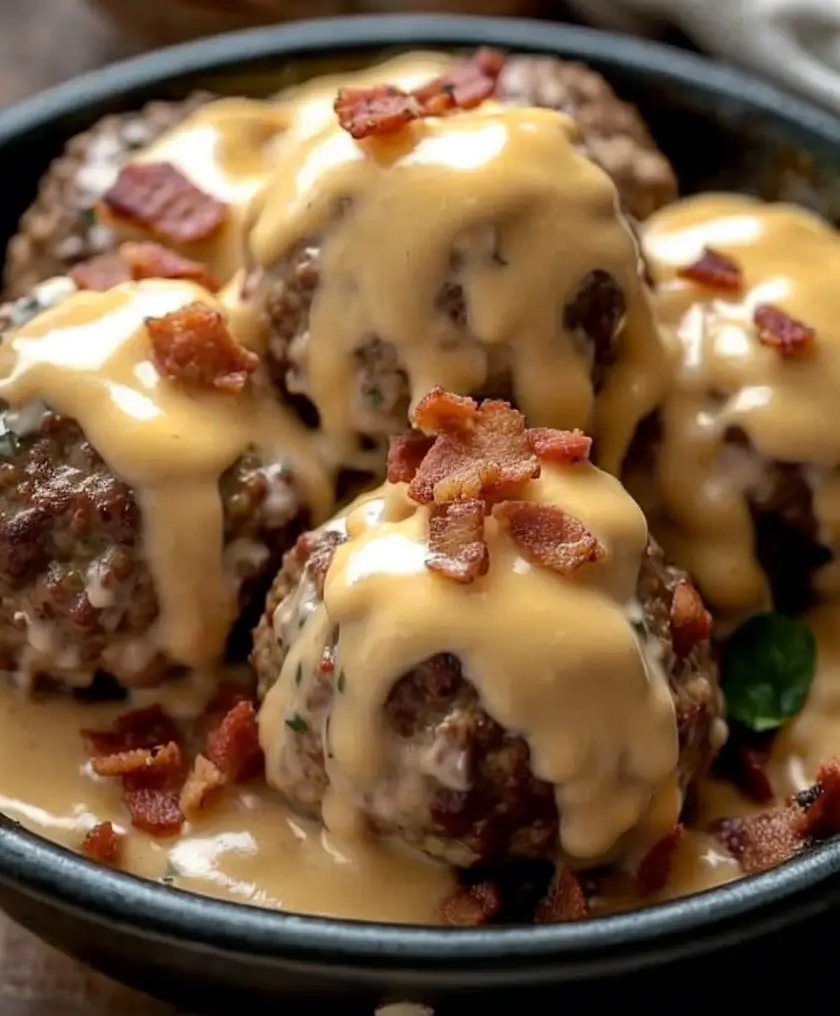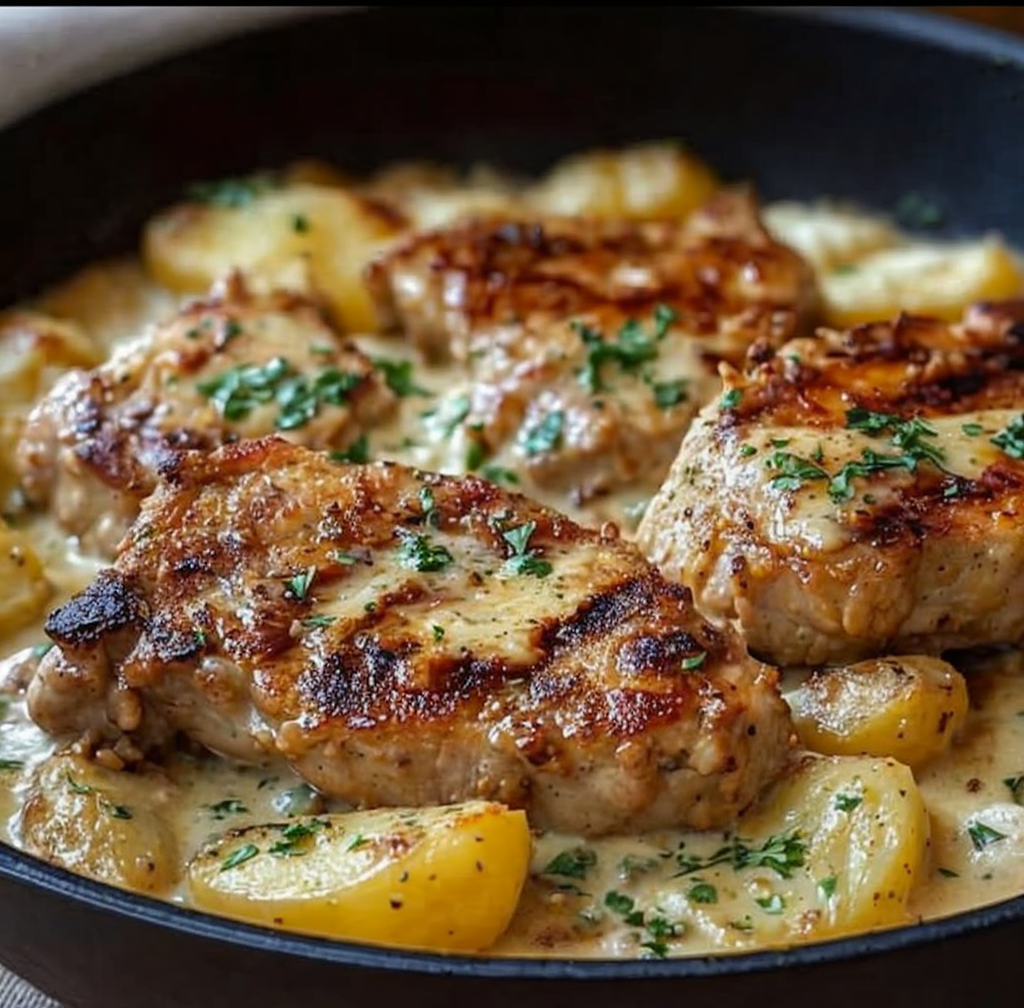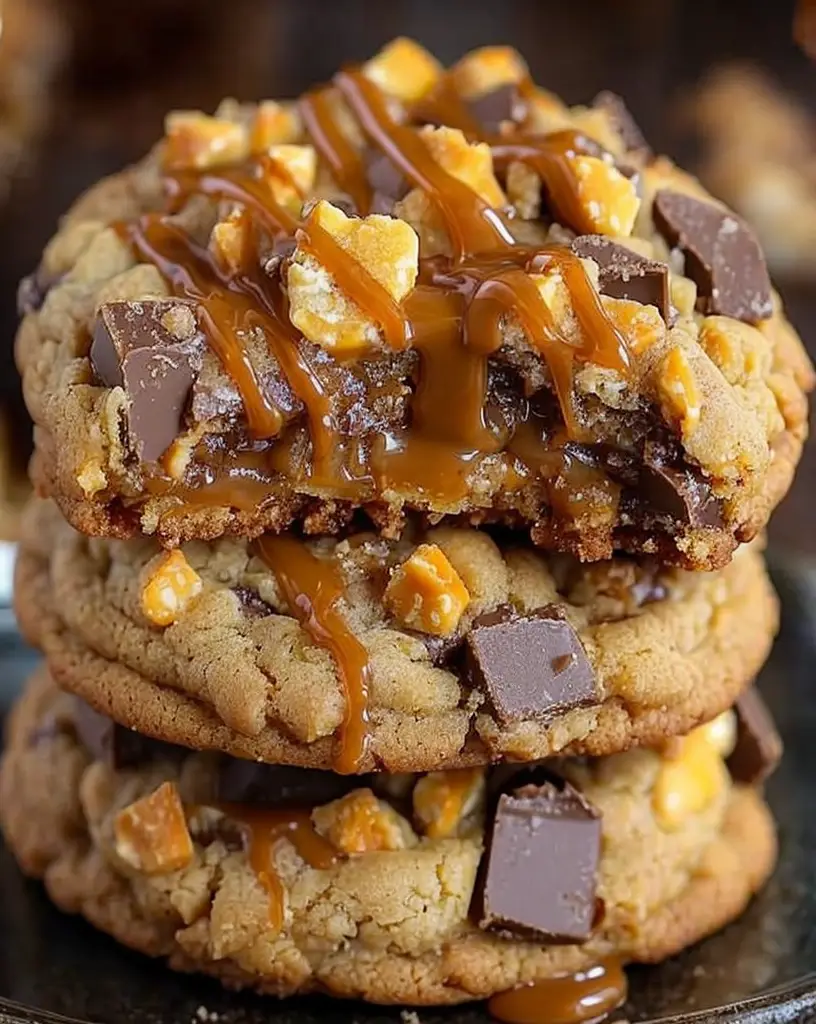Meatballs with Creamy Cheese Sauce and Crispy Bacon: A Decadent Delight
Indulge in the sumptuous flavors of our Meatballs with Creamy Cheese Sauce and Crispy Bacon. This delightful dish combines tender meatballs, a rich and velvety cheese sauce, and the irresistible crunch of crispy bacon. Perfect as a comforting family dinner or a showstopper for your next gathering, these meatballs are sure to impress. Each bite offers a symphony of flavors, with the creamy sauce enveloping the meatballs in a warm, delicious embrace. Your taste buds will thank you for this crave-worthy meal!
Imagine serving up a dish that not only pleases the palate but also makes your home smell heavenly. The aroma of fresh herbs mingling with sizzling bacon creates a warm and inviting atmosphere, perfect for sharing with loved ones. This recipe is not just about filling stomachs but creating memories around the dinner table, making it a favorite among comfort food enthusiasts.
Quick Recipe Highlights
- Flavor Profile: Savory and rich with a touch of smokiness from the bacon.
- Texture: Tender meatballs coated in a creamy sauce, with crispy bacon adding a delightful crunch.
- Aroma: Inviting scents of garlic, onion, and sizzling bacon waft through the air.
- Visual Appeal: Golden-brown meatballs topped with lusciously creamy sauce and flecks of crispy bacon.
- Skill Level Needed: Suitable for home cooks with basic culinary skills.
- Special Equipment: Skillet and baking dish.
Recipe Overview
- Difficulty Level: Medium due to the need for careful cooking of the meatballs and sauce.
- Category: Perfect as a hearty main course, this dish falls under comfort food.
- Cuisine: A fusion of classic Italian meatballs with an American twist of creamy sauce and bacon.
- Cost: This recipe is budget-friendly, with easily sourced ingredients.
- Season: Ideal for all seasons but especially comforting in colder months.
- Occasion: Great for weekday dinners and festive gatherings alike.
Why You’ll Love This Recipe
Meatballs with Creamy Cheese Sauce and Crispy Bacon are not just delicious; they are also a textural delight. The meatballs are tender and juicy, while the cheese sauce is luxuriously creamy and enveloping. When paired with the bacon’s satisfying crunch, this dish creates a captivating dining experience.
Preparation is quick and straightforward, making it a feasible choice for busy weeknights. The ability to prepare the meatballs in advance allows for easy assembly and less stress when mealtime arrives. It’s a convenience that caters to both time-strapped cooks and those looking to impress guests with little hassle.
Nutritiously, this dish offers protein from the meatballs and vitamins from the herbs. By using lean meat and fresh ingredients, you can make this dish healthier without compromising on flavor. It’s a great way to satisfy hunger while also feeling good about what you’re serving.
When it comes to entertaining, serving meatballs brings a casual yet celebratory vibe to the table. They are easy to share, making them perfect for gatherings. Your guests will appreciate the hearty flavors and comforting textures, forging connections over a shared dish.
This recipe is also cost-effective. With just a few staple ingredients, you can whip up a lavish meal without breaking the bank. The accessibility of the ingredients ensures that you can make this a regular feature on your dining table.
Historical Background and Cultural Significance
The history of meatballs dates back centuries, with various cultures putting their unique spin on the dish. Originating in Italy, meatballs were traditionally made from leftover meats and spices, which were crafted into shapes for ease of cooking and consumption. By blending meats, spices, and herbs, communities created unique flavor profiles that resonate within their culinary traditions.
Culturally, meatballs signify comfort and home-cooked meals. Families often gather around the dinner table to share stories and laughter while enjoying meatballs. Their significance extends beyond food; they symbolize warmth, family bonds, and communal experiences.
Over time, the evolution of the meatball has led to countless variations worldwide. From the Swedish köttbullar to the Middle Eastern kofta, each adaptation reflects local tastes and customs. This flexibility allows for creative expression within culinary traditions while retaining the essence of comfort food.
In regions like the United States, meatballs have been embraced in various forms, morphing into dishes such as spaghetti and meatballs, which celebrates Italian-American culture. Today, the basic meatball has transformed into a beloved dish worldwide, celebrated in numerous recipes.
Ingredient Deep Dive
Meat: Using ground beef, turkey, or chicken is common for meatballs. Each offers varying levels of fat, ensuring tenderness and flavor. Ground beef often provides a richer taste, while poultry is leaner and a healthier option. Look for meat with a balanced fat-to-lean ratio for optimal texture.
Bacon: Bacon is a delightful addition that enhances the overall dish. It brings a smokey flavor profile and crispy texture. When selecting bacon, opt for thick-cut varieties to achieve the best crunch. Proper storage involves refrigeration, while freezing can extend shelf life.
Cheese: Creamy cheeses like cream cheese or cheddar melt beautifully into the sauce. Cheese adds richness and flavor depth, creating that comforting element in meals. For storing, cheese should be wrapped tightly to avoid moisture loss. Various cheeses can be used interchangeably based on preference.
Herbs and Spices: Fresh herbs add brightness to the dish, while essential spices like garlic and onion provide depth. Herbs must be fresh for the best flavor, and dried versions can substitute in a pinch. Store herbs properly to maintain their fragrance and potency.
Common Mistakes to Avoid
- Overmixing Meat: This can lead to tough meatballs. Mix until just combined.
- Not Using Enough Fat: Insufficient fat can result in dry meatballs. Use ground meat with some fat content.
- Skipping Browning: Browning meatballs adds flavor; ensure they are seared properly before simmering in sauce.
- Ignoring Temperature: Cooking at high heat can burn the outside while leaving the inside raw. Maintain a steady heat.
- Overcooking Bacon: Bacon should be crispy but not burnt. Watch closely while cooking.
- Not Adjusting Seasoning: Always taste the mixture before cooking to adjust spices as needed.
- Using Cold Ingredients: Cold meat can lead to uneven cooking. Let it come to room temperature before preparing.
- Failing to Rest: Letting meatballs rest after cooking helps juices redistribute, enhancing flavor.
Essential Techniques
Rolling Meatballs: This ensures even cooking and a pleasing shape. Gently roll the mixture between your palms without compressing it too tightly. Aim for a consistent size to ensure even cooking. Check for doneness using a thermometer or by cutting one in half.
Browning: Browning meatballs develops a deeper flavor. Heat oil in a pan before adding meatballs, avoiding crowding to achieve brown crusts. If they stick, let them cook a little longer before flipping. Look for a rich golden-brown color as a cue for perfect browning.
Pro Tips for Perfect Meatballs with Creamy Cheese Sauce
1. Use day-old bread soaked in milk for moisture and flavor.
2. Experiment with different meats for varied taste experiences, such as lamb or veal.
3. Add finely chopped vegetables to the meat mixture for extra flavor and nutrition.
4. Don’t forget to season the cheese sauce with herbs to elevate its taste.
5. Bake meatballs instead of frying for a healthier option.
6. Garnish with fresh herbs to add freshness to the dish.
7. Serve with crusty bread or over pasta for a complete meal.
8. Allow the meatballs to simmer briefly in the sauce to absorb flavors.
Variations and Adaptations
Regional meatball variations can include ingredients like feta cheese or herbs specific to local traditions. This dish can be adapted seasonally by incorporating fresh herbs during the summer and using hearty root vegetables during winter. Vegetarian adaptations use lentils or chickpeas as a meat substitute, making it accessible for all diets.
For flavor variations, consider adding spices like paprika or cumin to the meat mixture. To modify texture, choose leaner meats for a softer bite, or opt for a coarser grind for added bite. Finally, consider alternative presentation styles by using skewers for meatball appetizers.
Serving and Presentation Guide
Plating techniques can elevate your dish. Use shallow bowls to highlight meatballs swimming in cheese sauce. Garnish with fresh herbs or a sprinkle of paprika for color. Traditional accompaniments like crusty bread or garlic knots work beautifully while modern twists might include servings on polenta.
Temperature plays a key role; serve meatballs hot for the best experience. As for portion control, consider three to four meatballs per serving, accompanied by sauce. This not only helps with servings but keeps meal options flexible.
Wine and Beverage Pairing
For wine lovers, a robust red such as a Chianti pairs perfectly with the meatballs. The wine’s acidity balances the richness of the cheese sauce. If you prefer non-alcoholic options, a sparkling water with lemon offers refreshing contrast without overpowering flavors.
For coffee enthusiasts, consider a light brew to cleanse the palate between bites. Serve iced tea as a chilled companion to this hearty dish, especially appreciated in warm weather. Each beverage enhances the meal’s overall experience.
Storage and Shelf Life
Proper storage involves refrigerating leftovers within two hours of cooking. Transfer meatballs to an airtight container for best results. They can be stored for 3-4 days, while freezing extends their life to about three months.
When reheating, ensure internal temperatures reach 165°F for food safety. For best texture, use the oven or stovetop rather than microwaving. When freezing, consider separating the meatballs and sauce to maintain texture.
Make Ahead Strategies
Prepare the meatballs in advance and refrigerate before cooking; they can be made a day or two ahead without losing flavor. Prepare the cheese sauce beforehand as well, placing it in an airtight container.
Freezing cooked or uncooked meatballs allows for quick meals, making weeknight dinners easier. When you’re ready to cook, simply thaw in the refrigerator overnight. Add fresh herbs just before serving for the best flavor impact.
Scaling Instructions
Halving or doubling this meatball recipe is straightforward. Adjust cooking time slightly when scaling up or down; larger batches may require more time in the oven.
If doubling, ensure your mixing bowl is large enough, or divide the mixture into smaller portions to manage effectively. When adjusting recipe size, also scale sauce ingredients to match the proportional increase in meatballs.
Nutritional Deep Dive
A controlled portion of meatballs can provide a balanced meal, offering protein, fats, and carbs. Lean meats offer high protein without excess calories, while the creamy sauce provides richness.
Consider analyzing micronutrient content by assessing the type of cheese used, as some may be higher in calcium or vitamin B12 than others. Eating with whole grains or vegetables boosts the nutrient profile while aiding in a balanced diet.
Dietary Adaptations
For gluten-free diets, replace breadcrumbs with crushed gluten-free crackers or oats. Dairy-free alterations can be achieved using coconut cream or nut cream as a base for the sauce.
Vegetarian options can employ mushrooms or lentils as substitutes, maintaining flavor and texture. For low-carb and keto diets, swap out traditional grains for cauliflower rice or zucchini noodles.
Troubleshooting Guide
For overly dry meatballs, ensure you’re not overcooking them; look for a moist and slightly warm center. If flavors lack depth, check that you’ve adequately seasoned both the meat mixture and the sauce.
If the cheese sauce splits, whisk in a bit of cream or cornstarch mixed with water to thicken. In situations where the sauce is too thick, add reserved pasta water or broth until the desired consistency is achieved.
Recipe Success Stories
Many home cooks have shared their success with this meatball recipe, highlighting the dish’s versatility. From BBQ-themed gatherings to midweek family dinners, recipe variations abound.
Readers often experiment with different sauces, sharing exciting adaptations like buffalo or teriyaki styles. Photographic shares reveal how beautifully the meatballs present, encouraging others to try their hand at what has become a beloved dish.
Frequently Asked Questions
Can I freeze the meatballs?
Yes, you can freeze meatballs either cooked or uncooked. Just ensure they are stored in an airtight container to maintain freshness for up to three months.
What kind of meat is best for meatballs?
Ground beef is traditional, but you can use ground turkey, chicken, or even plant-based alternatives for variation in flavor and nutrition.
How do I know when the meatballs are done?
Meatballs are done when they reach an internal temperature of 165°F. For even cooking, use a meat thermometer.
Can I prepare the meatballs a day in advance?
Absolutely! You can mix and form the meatballs in advance. Just refrigerate them and cook when ready.
What can I substitute for breadcrumbs?
Crushed crackers, oats, or parmesan cheese can substitute breadcrumbs to keep the binding effect without gluten.
Is it possible to make the dish dairy-free?
Yes! You can create a dairy-free sauce using coconut milk and nutritional yeast for added flavor.
What’s the best way to reheat leftovers?
The oven is ideal for reheating leftover meatballs, maintaining the texture without drying them out.
Can the sauce be made in advance?
Yes, the sauce can be prepared in advance and simply reheated when you cook your meatballs.
What sides pair well with meatballs?
Pair your meatballs with a side salad, pasta, or garlic bread to round out the meal wonderfully.
Can I use this recipe for meatloaf instead?
Absolutely! You can easily turn this meatball recipe into a delicious meatloaf by adjusting the cooking time accordingly.
Additional Resources
For those interested in exploring further, check related meal recipes, ingredient guides, or techniques on enhancing the perfect meatball. Equipment recommendations for making meatballs can also help streamline the cooking process. Seasonal variations can bring new twists, keeping your family intrigued with unique flavors throughout the year.
Join the Conversation
Engage with us via social media to share your own experiences with meatballs. Your photography tips and recipe reviews could guide fellow food enthusiasts on their culinary journeys. Consider sharing your variations to inspire creativity in our cooking community.
The Recipe
Meatballs with Creamy Cheese Sauce and Crispy Bacon
Serves: 4-6
Prep Time: 15 mins
Cook Time: 30 mins
Total Time: 45 mins
Kitchen Equipment Needed
- Large mixing bowl
- Skillet
- Baking dish
- Meat thermometer
Ingredients
- 1 pound ground beef
- 1 cup breadcrumbs
- 1 egg
- 1 teaspoon garlic powder
- 1 teaspoon onion powder
- 1 cup cream cheese
- 1/2 cup shredded cheddar cheese
- 1/2 cup cooked, crumbled bacon
- Salt and pepper to taste
- Fresh parsley for garnish
Directions
- Preheat the oven to 375°F (190°C).
- In a large bowl, combine ground beef, breadcrumbs, egg, garlic powder, onion powder, salt, and pepper. Mix until just combined.
- Form the mixture into meatballs, about 1-inch in size.
- In a skillet over medium heat, sear the meatballs until browned on all sides, about 5-7 minutes.
- Transfer the meatballs to a baking dish and bake for 15 minutes or until cooked through.
- In the same skillet, add cream cheese and shredded cheddar, stirring until melted and smooth.
- Stir in crumbled bacon and adjust seasoning as necessary.
- Pour the cheese sauce over the baked meatballs, and return to the oven for 5 more minutes.
- Serve hot, garnished with fresh parsley.
Recipe Notes
- Experiment with different cheeses for unique flavors.
- Keep leftovers in an airtight container in the fridge for up to 4 days.
- These meatballs freeze well; just reheat in the oven when ready to serve.




